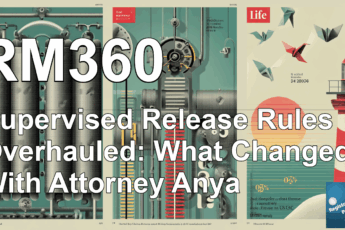When it comes to sentencing in the United States, most people assume there should be a uniform standard applied across the country. After all, crime is crime, right? But the reality is far more complex. A sharp observer, Christopher, posed a thought-provoking question about why sentences for similar crimes differ drastically between state and federal systems. For instance, why does someone convicted of trading inappropriate images in one state receive probation, while their federal counterpart gets a 60-month prison sentence? This discrepancy raises questions about justice, fairness, and the interplay between state and federal law. To answer Christopher’s question, we must dive into the unique structure of the U.S. legal system and the cultural, political, and historical factors that shape it.
The Federal-State Divide: Understanding Sovereignty
The United States operates under a federalist system, meaning power is shared between the federal government and individual states. What’s often misunderstood is that federal and state governments are separate sovereigns. Each has its laws, courts, and law enforcement systems. This separation is enshrined in the Constitution and underpins the legal framework we navigate every day.
How This Applies to Criminal Law
Both the federal government and states have authority over certain crimes, but their jurisdictions don’t always overlap. For example:
– State Crimes: These are offenses traditionally handled by states. Crimes like robbery, assault, and certain drug violations often fall under state jurisdiction.
– Federal Crimes: These involve issues that cross state lines or affect national security—like organized crime, large-scale drug trafficking, or using the internet to trade illegal images.
This dual system can result in vastly different outcomes for the same crime. Let’s consider Christopher’s example: one offender used a foreign-made device flagged by a national task force, while the other engaged in similar activity within their state. The technology’s involvement provided a federal jurisdictional hook, automatically triggering stiffer federal sentencing guidelines.
The Legacy of the Sentencing Reform Act of 1984
To understand the vast disparities between state and federal sentencing, we need to rewind to the 1980s, specifically to the Sentencing Reform Act of 1984. This piece of legislation reshaped the federal system in ways that still impact sentencing today.
The Pre-1984 Landscape
Before 1984, federal sentencing was chaotic and inconsistent. Federal judges had broad discretion, often leading to significant variations in sentences for the same crimes. Additionally, parole was an option, meaning offenders could often secure early release after serving only a small portion of their sentence.
Reagan’s Tough-on-Crime Revolution
The 1980s marked the rise of the “tough-on-crime” era, fueled by political priorities and public sentiment. With Ronald Reagan in office, there was a growing perception that the justice system was too lenient. People wanted harsher punishments, especially for federal crimes.
The Sentencing Reform Act was a direct response. Key elements of the Act included:
– Elimination of Parole: Parole was abolished, turning sentences into mandatory terms.
– Guideline-Driven Sentencing: The Act introduced federal sentencing guidelines that minimized judicial discretion and established mandatory minimums for many offenses.
– Focus on Incarceration: Probation and alternative sentences became rare in federal cases, with the default punishment being prison.
The consequences of this are staggering. In 1980, the federal prison population hovered around 20,000. By the end of Reagan’s presidency in 1988—just four years after the Sentencing Reform Act—the number had nearly tripled to 57,000. Fast forward to the 2000s, and the federal prison population exceeded 200,000 inmates.
Why State and Federal Sentencing Differ
The question of disparity between state and federal sentencing comes down to philosophy, resources, and the flexibility of sentencing frameworks. Let’s break these down:
1. Political Will and Public Opinion
In the federal system, tough sentencing is often driven by political narratives. Elections and public sentiment shape how lawmakers approach crime and punishment. The Reagan-era “war on crime” reflected collective outrage about perceived criminal leniency, establishing harsh penalties at the federal level.
2. Sentencing Guidelines
Federal sentencing guidelines are far more rigid compared to state systems. This stems from the 1984 Act, which prioritized consistency over flexibility. By contrast, state systems still allow for more judicial discretion, leading to wildly varied outcomes.
3. Resource Differences
State governments juggle numerous responsibilities, such as infrastructure, education, and healthcare, alongside managing prisons. This often forces states to adopt rehabilitative approaches or shorter sentences simply because they don’t have the resources to house offenders long-term. The federal government, with its larger budget and national focus, has fewer constraints when it comes to incarceration.
4. Jurisdictional Hooks
Federal jurisdiction often hinges on specific triggers, like crimes crossing state lines, technological involvement, or use of federal property. These hooks frequently push cases into the federal system, where mandatory minimums and stricter penalties apply.
Impacts of Federalism on Criminal Sentencing
Christopher’s question—and his suggestion about uniform laws across the country—challenges the very idea of federalism. The United States deliberately operates as a union of individual “experiments in democracy,” where states have the power to legislate their own criminal codes. This structure allows diversity in policy but also creates inconsistencies.
A Unitary System
If the U.S. adopted a unitary system like Canada or the U.K., crimes would be prosecuted under a single national framework. There’d be no disparities between states because all courts would follow the same sentencing guidelines. However, such a system would fundamentally alter the balance of power between states and the federal government—an unlikely scenario given U.S. history and legal traditions.
Benefits of Federalism
The current system has its merits. It allows states to serve as democratic laboratories, experimenting with different policies. Some argue this can lead to innovation and improvement as states adopt successful practices from each other. But critics note the opposite is often true in the criminal justice arena—states race to impose harsher penalties to appear tough on crime, perpetuating a cycle of mass incarceration.
Why Harsh Sentencing Persists
As Larry, the speaker in the source material, highlighted, “We the People” bear responsibility for sentencing policies. Politicians reflect the values and priorities of their constituents. Over the past four decades, voters have consistently supported “tough-on-crime” rhetoric through their choices at the ballot box. Efforts to reform the criminal justice system—like the First Step Act of 2018—have historically been diluted by fierce political opposition.
Change is unlikely until the public demands it. Voting patterns reveal a persistent appetite for severe sentencing, particularly at the federal level. Until that shifts, federal prisons will remain disproportionately full, and sentencing inconsistencies will persist.
Conclusion: A Complex and Unfinished Debate
The disparities between state and federal sentencing remain a reflection of America’s federalist structure and cultural values. While it’s tempting to wish for a unified system, such a change would require reevaluating the balance of power between states and the federal government—something deeply embedded in the Constitution.
In the end, sentencing disparities aren’t just a legal issue; they’re a societal one. Christopher’s thought-provoking question underscores the importance of civic engagement. The power to reshape America’s sentencing practices lies with its people. Whether through voting, advocacy, or education, citizens must decide whether they want reform—or more of the status quo. The question is not just what kind of legal system we have, but what kind of society we want to be.
Call to Action:
- Learn More: Understand the Sentencing Reform Act’s impact and federal-state sovereignty.
- Get Involved: Advocate for criminal justice reform through local and national organizations.
- Vote Wisely: Examine candidates’ platforms and hold them accountable for their positions on sentencing laws and mass incarceration.




Leave a Comment